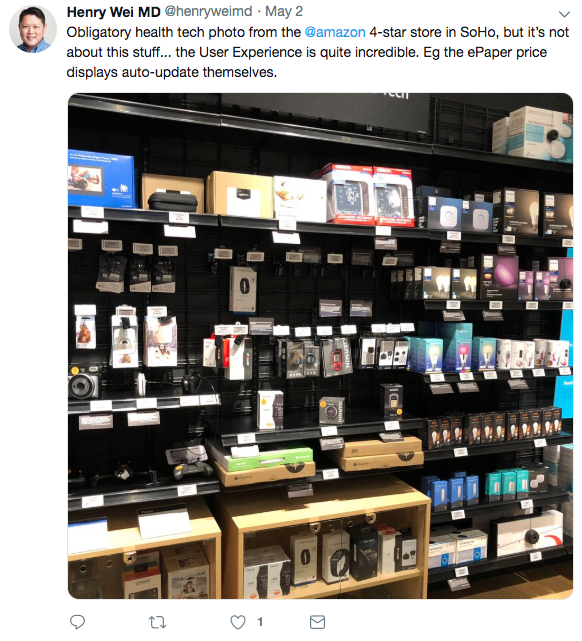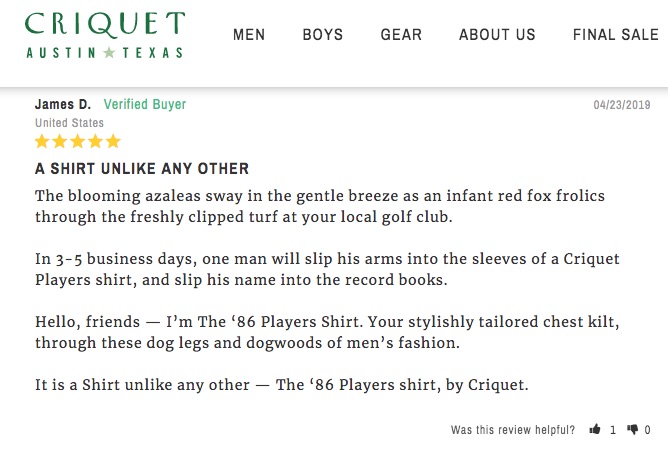Shopping online definitely has its perks. Not only can you stay in your pajamas, but ecommerce websites make it simple for customers to find important details from ratings and reviews and in-depth product descriptions. However, shopping in person remains a completely different experience.
Why is that?
For starters, very few brick and mortar stores currently have in-store displays with reviews.
As a result, many consumers result to searching product reviews on their smartphones while standing in the store’s aisle. In fact, data from Salesforce and Publicis Sapient discovered that 71% of shoppers use their phones to research products while in the store.
In-store customers lack the same detailed information that they can access online. That’s why displaying product reviews in-store is a great way to provide customers with the confidence and information needed to buy your products.
In this post, we’ll highlight a few companies that have taken creative steps to solve this problem and share some general tips to in-store displays showing reviews:
Amazon 4-Star Stores
Unsurprisingly, Amazon sits at the cutting edge of in-store review displays. Last year the retailer opened its first Four-Star Store, primarily offering products with 4+ star online ratings.
The stores display reviews by using a small electronic tag on the shelf, updated with star ratings and prices from the Amazon website. This gives shoppers an entertaining experience, while also providing important product information.
https://twitter.com/mims/status/1130633538536185856
While this appears innovative compared to most in-person stores, it still lacks the detail available online. Customers cannot read, search, sort or filter reviews the way they can on the internet.
In addition, these electronic tags appear surprisingly low-tech. They use the Kindle style “ink text,” rather than LED display, which limits the colors and graphics available for customization.
3.8 Star Amazon Basic Toaster at the Amazon 4-Star store 😀 pic.twitter.com/xuwQX1WIWy
— Jason Goldberg (@retailgeek) May 8, 2019
Despite the 4-star branding, the store’s primary focus is to cross-sell Amazon’s private label products and Prime subscriptions. However, every product in the store comes with immediate social proof by virtue of its high rating. Overall, Amazon’s Four Star store ranks as the most prominent in-store use of customer reviews.
Ulta Beauty Reviews Kiosks
While Amazon remains the only major retailer to design a full store around reviews, other companies also display reviews in their brick-and-mortar locations. For example, makeup retailer Ulta Beauty has seen recent growth in in-store sales, due to a revised focus on in-store technology and updated merchandising.
Ulta has also successfully installed “reviews kiosks” in its stores. These kiosks sell products with high customer reviews on Ulta’s website.
https://www.instagram.com/p/Bxxw41KHl_v/
While these kiosks are rare, Ulta still does a great job using customer feedback to drive in-store purchases. Shoppers passing by these specific shelves know the products have good reviews and understand they’re quality products.
Hats off to a successful use of reviews to drive in-store sales!
Yeti
Even if your brand can’t create a review-centric store or kiosk, other brick-and-mortar stores have creatively displayed customer reviews. For example, YETI prints reviews on product inserts surrounding their coolers.
https://www.instagram.com/p/Byn78ednIBj/
These inserts feature only one review, but still provide social proof needed to help shoppers buy the product. The company does a good job at highlighting what their customers have to say–going beyond typical online reviews.
SPAM
You might not have seen this coming, but the official SPAM museum in Minnesota also publishes online reviews in-store. Tourists and museum guests can read reviews of SPAM products prominently displayed on a large wall in the museum.
‘@SpamMuseumMN is the mecca of canned-meat’ via @Thrillist: https://t.co/68LPP6kMFb pic.twitter.com/mSkqCuIyAA
— Hormel Foods (@HormelFoods) June 30, 2017
Spam’s creative customer feedback tactic helps promote their brand and its customers in a fun way.
Nordstrom
In-store apps provide yet another way for retailers to use reviews. In fact, mobile apps continue to be an integral part of the in-store shopping experience, providing customers with detailed product information while browsing the aisles.
Nordstrom has successfully incorporated its app into the live shopping experience. In addition to reviews, Nordstrom’s app features 3D visualizations of how suits and outfits would fit their prospective shoppers.
https://www.instagram.com/p/Bj-wv8alcom/
Mobile apps are an efficient way to help customers read reviews while they browse in store.
How to Best Use In-Store Displays for Reviews
Because few companies have in-store displays for reviews, showcasing any customer feedback will put you ahead of your competitors. Still, when you decide to display reviews, you’ll want to be smart about it, so follow these tips:
1. Draw Attention to the Reviews
Like the proverbial tree-in-the-woods, if you display reviews in-store but no customers read them, it won’t do much to improve sales. Amazon Four Star stores do a great job of ensuring customers notice the reviews- even the name of the store highlights reviews!
Because many stores don’t use reviews, drawing attention to the reviews helps your store stand out from its competitors. Along similar lines, the Ulta kiosks also attract shoppers to the in-store reviews.
The large kiosks look different than the rest of the store aisles, helping to make sure customers notice the products with reviews. For in-store review displays to have any impact, you must make the displays visible and noticeable.
2. Keep Review Content Fresh & Up-to-Date
When shopping online, your product reviews will update automatically. But for in store, updating reviews requires a bit more thought. It doesn’t do your shoppers any good to see outdated reviews left a few years ago.

Also, as you begin selling new products in your store, you will want to have updated reviews. Making sure the reviews are current and up-to-date should be a priority for your in-store reviews.
One way to update your in-store reviews is to use digital shelf labelling, like Amazon Four Star and now even Walmart. This technology is relatively new and few stores have started implementing it, but does present an easy way to automatically update in-store reviews.
Walmart conducting pilot test of electronic shelf labels, LED strips https://t.co/a8ip2TXzP2 every retailer trying to cater to digitally influenced shoppers. 2019 will be the year of Digital Fact Tags (Amazon, Best Buy, Walmart, Sams, Kroger, Walgreens, etc…)
— Jason Goldberg (@retailgeek) February 16, 2019
The digital labels can link up to the products online PDP, keeping the in-store star rating current. If digital labels don’t work for your store, it is still worthwhile to make a conscious effort to update the physical review displays.
However, if you find yourself rarely updating the reviews of a given product, that can work as a good reminder that this product needs more reviews, perhaps through a product sampling campaign. For these reasons, it is important to maintain and refresh the in-store review displays.
3. Use Both Summarized & Individual Reviews
Posting an aggregate review total (the review summary, such as “4.6 out of 5 stars, 1,132 reviews”) is the most important part of your review display. Customers want to know both a general product rating and the number of people that have left reviews.
In addition to the summarized rating, showcasing individual reviews is a great way to engage with your customers. Highlighting a basic “nice product, I liked it” review probably won’t have much impact.

However, displaying a creative and amusing review allows your customers to brag about your product for you. For example, Criquet Shirts profiles this Masters-themed review on its website- and could easily do the same in-store.
Main Takeaways
While collecting online reviews is par for the course in e-commerce, not many companies use review content in their physical stores. A few leading retailers- like Amazon and Ulta- have taken strides in displaying reviews in-store.
Other brands, including YETI, SPAM, and Nordstrom, also are innovative in the way they share reviews. When using your reviews in-store, it helps to make reviews the center of attention. Likewise, it’s important to update the review displays with your most recent content.
In addition to displaying the aggregate review total, highlighting a few specific stand-out reviews works as a fun way to engage with your customers. Overall, in-store displays represent an exciting untapped area that retailers will increasingly take advantage of in the coming years.





